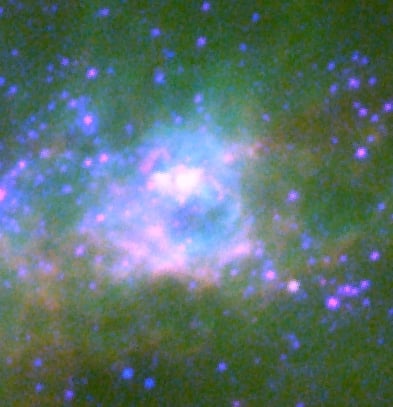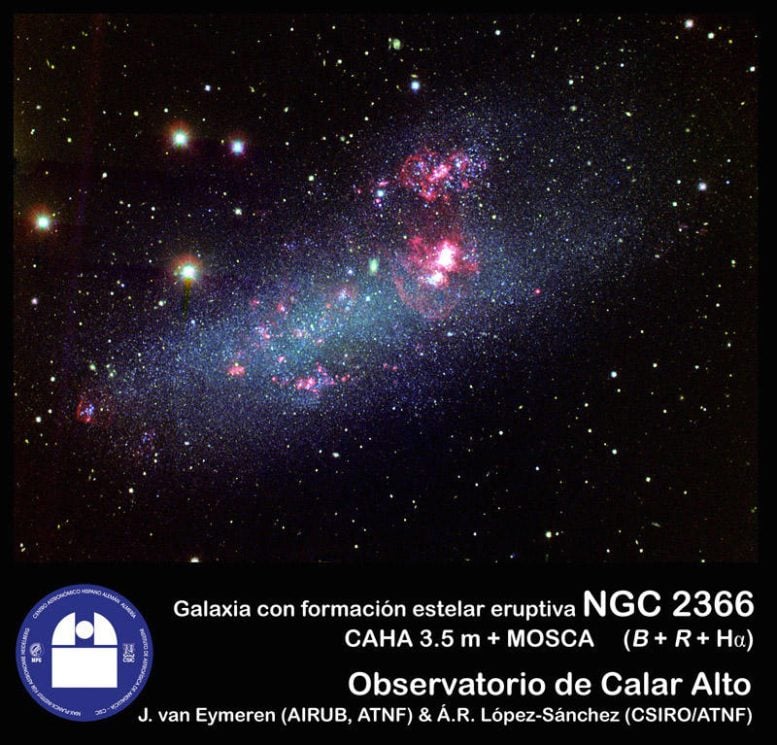University of Michigan astronomer Sally Oey studied a star-forming region in the host galaxy NGC 2366, a typical dwarf irregular galaxy.Image credit: Observatorio de Calar Alto, J. van Eymeren (AIRUB, ATNF) & Á.R. López-Sánchez
If you gaze at huge galaxies filled with countless stars, it’s easy to think of them as stellar factories churning out bright balls of gas. However, less evolved dwarf galaxies have larger star factory regions and higher star formation rates.
A new discovery by University of Michigan researchers sheds light on this phenomenon: Dwarf galaxies experience a delay of about 10 million years before expelling the gas that clogs their space. This delay allows the star-forming regions in these galaxies to retain their gas and dust longer, allowing more stars to form and develop.
Dwarf galaxies: the cradle of star formation
In these relatively primitive dwarf galaxies, massive stars (those with a mass of about 20 to 200 times the mass of the Sun) collapse into black holes rather than explode into supernovae.But in more evolved, more polluted galaxies, such as ours Milky Way, they are more likely to explode, creating collective superwinds. Gas and dust were ejected out of the galaxy, and star formation soon ceased.

A cross-section of Mrk 71-A taken by the Hubble Space Telescope, showing a region showing strong radiative cooling (and therefore a lack of superwinds).Image credit: Observatorio de Calar Alto, J. van Eymeren (AIRUB, ATNF) & Á.R. López-Sánchez
Their findings were published in The Astrophysical Journal.
“When stars go supernova, they pollute the environment by producing and releasing metals,” said Michelle Jecmen, an undergraduate researcher and first author of the study. “We suggest that at lower metallicities – relatively uncontaminated galactic environments – the onset of strong superwinds is delayed by 10 million years, which in turn leads to higher star formation.”
Hubble’s tuning fork and galactic classification
Researchers at the University of Michigan point to the so-called Hubble tuning fork, a diagram depicting the way astronomer Edwin Hubble classified galaxies. Inside the tuning fork’s handle is the largest galaxy. These galaxies are huge, round, and full of stars, and they have turned all their gas into stars. Along the tines of the tuning fork are spiral galaxies, which literally have gas and star-forming regions in their dense arms. At the end of the tuning fork tines are the least evolved, smallest galaxies.
“But these dwarf galaxies do have these real star-forming regions,” said Sally Oey, an astronomer at the University of Michigan and senior author of the study. “There are some ideas as to why, but Michel’s discovery provides a very good explanation: These galaxies have a hard time stopping their stars from forming because they don’t blow away their gas.”
In addition, this quiet period of tens of millions of years provides astronomers with the opportunity to observe something similar to the cosmic twilight (the period of time after the dawn of the universe). big Bang, Jackmon said. In primordial dwarf galaxies, gas clumps together and creates gaps through which radiation can escape. This previously known phenomenon is known as the “fence” model, in which UV radiation escapes between the slats of a fence. This delay explains why the gases have time to clump together.
Cosmic Dawn and Ultraviolet Radiation
Ultraviolet radiation is important because it ionizes hydrogen—a process that also occurred after the Big Bang, causing the universe to change from opaque to transparent.
“So observing low-metallicity dwarf galaxies with lots of ultraviolet radiation is a bit like looking back at the dawn of the universe,” Jackman said. “It’s very interesting to understand the time around the Big Bang. It’s the basis of our knowledge. This happened so long ago – it’s so fascinating that we can see something similar in galaxies that exist today.”
observational evidence
The second study was published in Astrophysical Journal Letters and led by Oey, using Hubble Space Telescope Observe Mrk 71, a region of nearby dwarf galaxies about 10 million light-years away. In Mrk 71, the team found observational evidence of the Jecmen scene. Taking advantage of new technology with the Hubble Space Telescope, the team used a filter set to observe the light from triple ionized carbon.
In more evolved galaxies, there are numerous supernova explosions, which heat the gas in the cluster to very high temperatures — millions of degrees Kelvin, Oy said. As this hot superwind expands, it blows remaining gas out of the cluster. But in a low-metallicity environment like Mrk 71, the star doesn’t explode and the energy in the region is radiated away. It has no chance of forming super winds.
The team’s filter captured the diffuse light from ionized carbon throughout Mrk 71, showing that energy is being radiated away. So there are no hot superwinds, but instead dense gases remain throughout the environment.
Oye and Jackman say this has many implications for their work.
“Our findings may also be important in explaining the properties of galaxies seen at the dawn of the universe. James Webb Space Telescope Now,” Oy said. “I think we’re still in the process of understanding the consequences.”
Reference: “Delayed Mechanical Feedback in Massive Stars at Low Metallicities,” by Michelle C. Jecmen and MS Oey, November 21, 2023 The Astrophysical Journal.
DOI: 10.3847/1538-4357/ad0460
“Imaging of nebula C iv λ1550 of the metal-poor starburst Mrk 71: direct evidence of catastrophic cooling” by MS Oey, Amit N. Sawant, Ashkbiz Danehkar, Sergiy Silich, Linda J. Smith, Jens Melinder, Claus Leitherer, Matthew Hayes, Anne E. Jaskot, Daniela Calzetti, You-Hua Chu, Bethan L. James, and Göran Östlin, November 21, 2023 Astrophysical Journal Communications.
DOI: 10.3847/2041-8213/ad07dd
#Unraveling #mysteries #Milky #Dwarf #galaxies #revealed #unexpected #powerhouses #star #formation
Image Source : scitechdaily.com
